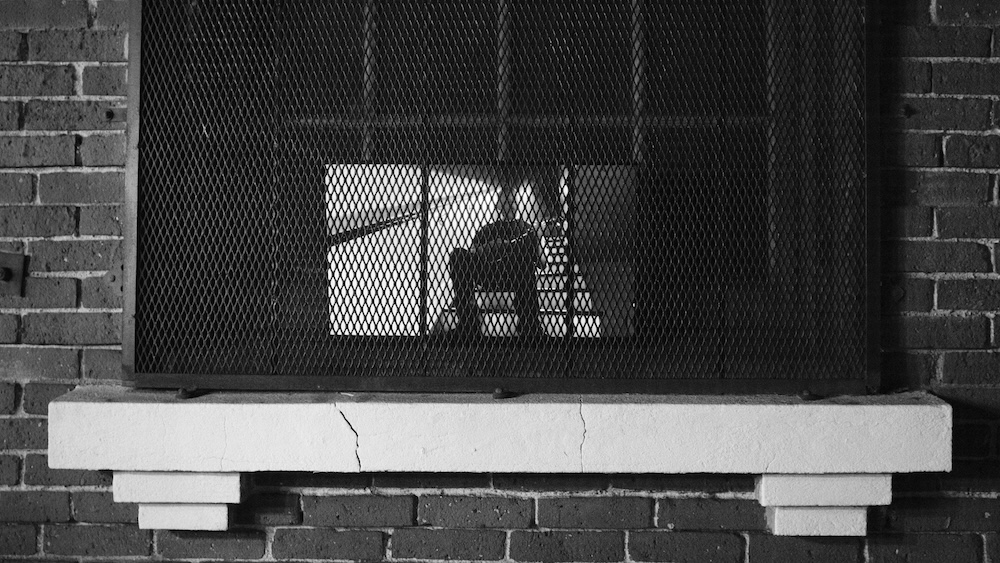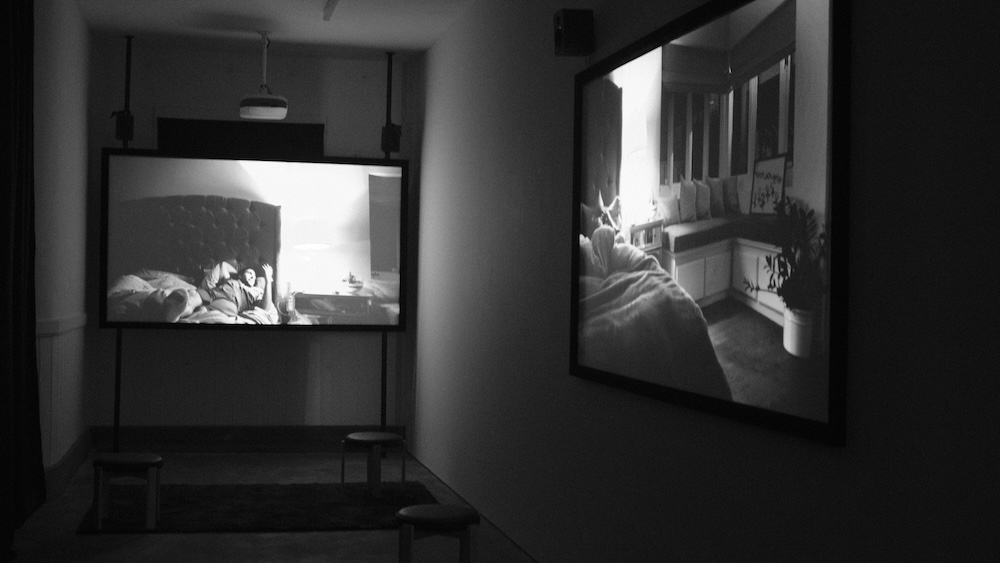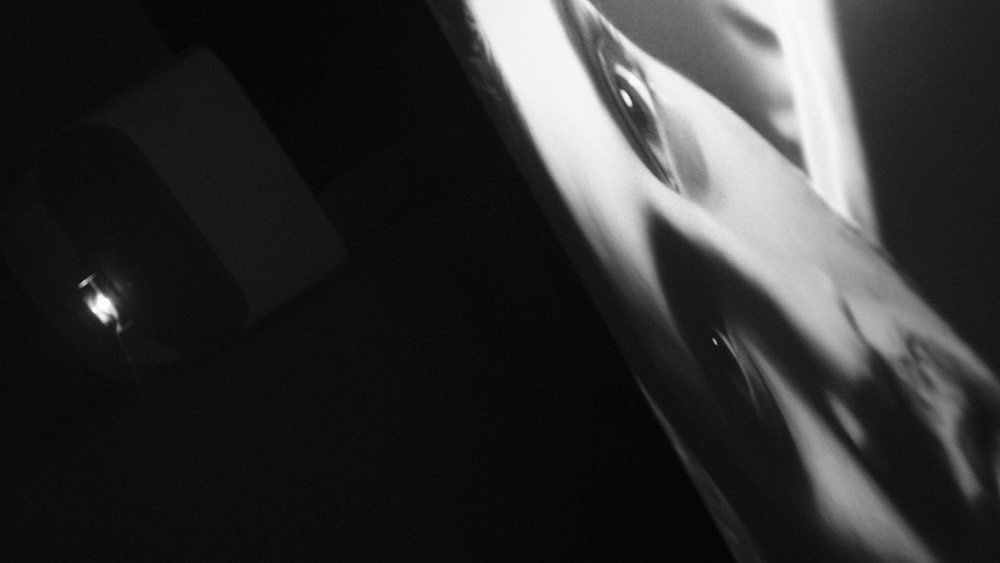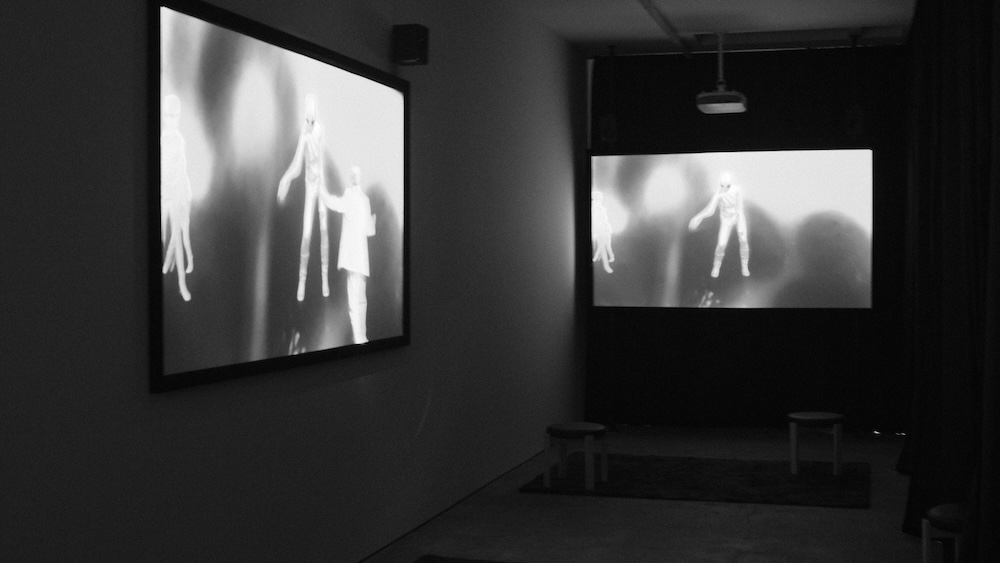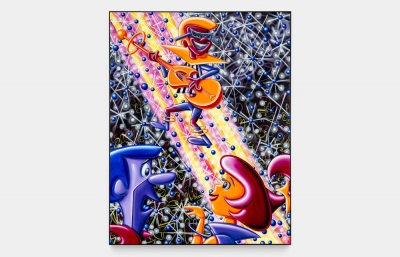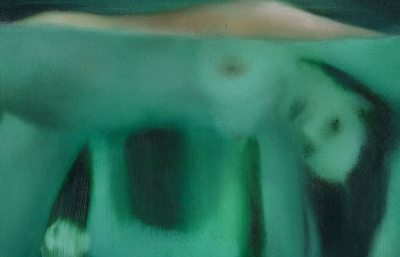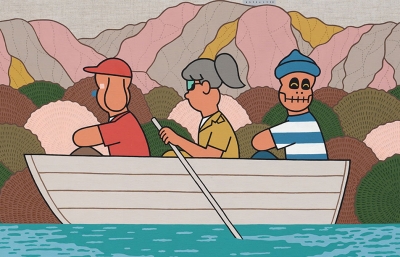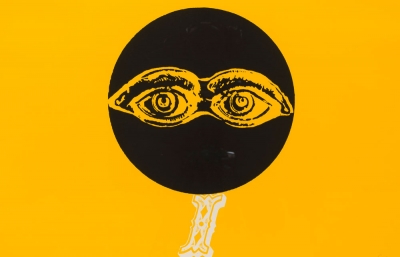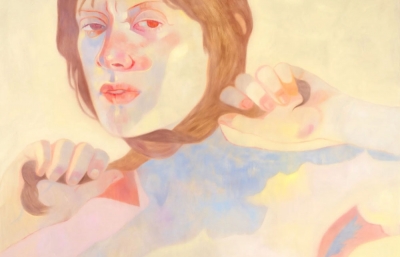The idea for filmmaker Andrew Bujaski wasn't to make a pandemic film, but the circumstances ahead of him presented itself in such a way that filming during the height of the pandemic would lead to an experiment. Maybe it could be called a true islotion film, but 2022's There There, was made with actors alone and separate, filmmakers directing via Zoom, iPhones as cameras and, as it turned out, a chance to reimagine it's production as an art piece. After the traditional release, the director known as the "godfather of Mumblecore" transformed There There into an installation about the edit, taking the original film and performances and creating an atmospheric and smart 3-screened presenation in Los Angeles' Rusha & Co gallery. The effect is an emphasis on acting, editing, writing and, regardless of the era of when it was filmed, the intensity of vulnerable isolation and desire for human connection. Here is our recent conversation with Bujaski about the genesis of the film, the current state of filmmaking and the evolution and potential of the audience.
Evan Pricco: You know what I did this morning? For a second, I looked at the Pitchfork Music top albums “so far of 2024,” just to see how much I knew. And I wasn't sure if what I had listened to or what I hadn’t was a sign that I am… of something.
Andrew Bujalski: Yes, that you are of something.
I was hoping for some sort of epiphany.
I have a friend who's a film critic of a certain age, he's a generation older than me, and he talked about how, when he was young, with movies, there was an idea that you could see all the great movies. There was a canon. If you devoted your life to it, you could catch up to it. And then that's long since blown away. You could not possibly catch up to everything great that comes out this year, let alone of all time.
I was listening to the New York Times interview podcast, and it was the CEO of Netflix was on, and he was saying how his son watched Lawrence of Arabia on his iPhone. And I was like, who am I to judge? But you're making films that you want people to see, and the landscape of seeing capital F “Film,” pandemic or otherwise, has changed, obviously.
Well, and it's been in a constant state of flux for all time... I'm always reminding myself that. I certainly have an inherent fogeyism. I love all the old stuff, and I still have my head in all the old stuff all the time, and I've gotten way too out of touch with the new stuff. But I remind myself frequently that there was never... I guess what I’m trying to say that this change in the way of film and filmmaking isn't new. If I had been making movies in the 1920s, by the time we got to the 1940s, I would be lost.
Movies are always on the axes of technology and economy and culture, and none of those things stand still. And particularly recently, of course.
Format's a weird thing, because I am old school. I'm a 35-mm guy. I look at what Austin Film Society is showing, I look at what Alamo Drafthouse is showing. If they're showing a print, then I'll be there. And if they're showing a DCP (Digital Cinema Package), I'll be grumpy. But by the same token, I think all the time that I grew up watching stuff on cruddy TVs, and it's fine. It gets across. I think of people in the 1960s with transistor radios listening to the Beatles, and it still came across, even though the sound is shitty. It doesn't matter that much. And Lord knows, we've probably gone too far the other way, where now there's this obsession with perfect digital technology, which I don't like. I'd much rather watch a beat up 35 print than a pristine DCP.
Art should be malleable and fluid. So when you started making your first films, you're already sort of aware that the landscape is always going to be changing?
I've never followed a trend on purpose. I've never been good at it. I mean, I've tried and failed. When I've ever tried to write something quasi-commercial, it never went anywhere. Because you look at what's hot right now? First of all, I don't know what's hot right now. Second of all, I certainly don't know how to replicate it. But I have had these lucky moments where an idea that I had or wrote hits or people respond to it for a certain reason, usually it's because I'm so far behind the trend that I inadvertently might have gotten ahead of the next cycle or something.
So this leads exactly to what I was going to ask you about the Mumblecore movement. It was ahead of the trend, but it's actually kind of just like making a film. It was honest in a time maybe where honest filmmaking was sort of losing out to that axes of technology.
We were way behind. And if anything, I would've... We shot Funny Ha Ha in 2001. And for me, I was trying to make the last indie feature of 1988, which is why I think it might have felt new to people accidentally, because we skipped an era. And I think that period, whatever was happening in indie filmmaking was somewhere between “Let's all imitate Tarantino and let's all imitate Wes Anderson.” And we weren't doing that. But it wasn't anything new. I think the only thing new about it is that we had our own young people rhythms. We happened to sound a little different and dress a little different.
So I appreciate that. I get that there is a generational thing, and everybody has to reinvent it. We were trying to push aside as much received wisdom as we could and reinvent the wheel. Everything I do, I'm trying to do that. That's what this installation is: me knowing nothing about how to make an installation and saying, “Well, here's how I would do it in my clunky way.” That's kind of the only way I've ever known how to work, for better or worse.
I think I asked you that in passing when we were in the gallery, but There There wasn't filmed with the intention of being presented this way.
The original, the movie version, the one-screen version is an art experiment. And so in some ways, it was already halfway to what it is now in the three-screen version. But yes, as I was finishing it, I was thinking about what we had done, and thinking that there was a direction we could push further. It certainly is complete as a movie, and yet I thought, we can also cube this out? What is the new edit?
Was the film conceived with the idea that it was going to have to be filmed this way, with the actors alone with their own iPhones, filming themselves? Or did that become a necessity?
That was the core of the idea. I've struggled with this all through the promotion of the movie, where people are eager to pin it as a COVID lockdown project. And I struggle with that, because I'm well aware that nobody wants to see a COVID lockdown project. And it is true that that was certainly part of the inspiration, was sitting there at that first moment, I think in the first weeks of sitting at home, and trying to avoid other humans, having this idea of, well, that takes off the table everything I know about movie-making? What is available and what is opened up by that? And what it led to pretty quickly for me was this grand editing experiment, which has a lot more to do with just the process of cinema. So I always shied away from calling it a COVID thing, because it was a bigger experiment to me than that.
It’s weird right? To see a film or TV show that pretends that the pandemic didn’t happen, or ones that really go over the top to over-explain COVID. I struggle with both. I don't quite know what's right at the moment.
Nobody knows. And I'll be curious to know what the landscape of that is 10 or 20 years from now, and we look back on it. I think it immediately became clear to filmmakers, people don't want to see this on screen. And we weren't trying to portray COVID on screen either. What we were trying to portray was isolation, certainly, but also the challenge of connection and the work of connection, which I think for me is what my work has always been about anyway. It's been about people struggling to find each other. And so this made that pretty literal, but it also gave us an opportunity to do something we'd never done before.
You have to try new tricks, of course.
Most of what I knew about filmmaking, I had to throw out. Most of what I know about filmmaking is, let's all get together and create a warm environment, and try to grow some flowers in that. And that was all gone. In a way, we were making... I mean, we joked that it was like we were making a green screen movie, but we couldn't afford the green screen. It had to be kind of dark and difficult, and in some ways impersonal. Of course, I'm still doing whatever I can as a director to connect with my performers, to connect with the crew, to try to make people feel happy to be there. But it was grueling. It wasn't fun for anybody, I think.
And to be clear, when I was directing, I wasn't in the room either. I was on Zoom, my DP was on Zoom, the producers were on Zoom. So we made this all over the States, and we also shot some in Italy and Germany, and I never left my desk. I don't recommend it. I don't plan to ever make another movie this way. But for this one, that was the nature of the experiment and what we had to do.
What's been the response from the actors?
It's a good question. I haven't had in-depth conversations with everybody, but I think you don't sign up for something like this if you're not a little crazy and willing to take the chance on it. It tends to be self-selecting, this kind of work. Divas and prima donnas don't show up for this kind of thing.
I’m curious, as a filmmaker, what do you think has changed the most in an audience since you started making films?
That's a great question. I've probably been afraid to ask myself that question.
And it's a pretty essential question. I think it's very helpful, if you're going to sit down and make something, if you're going to motivate yourself to do all this painful work to create something, it's great to have an ideal audience member in mind. And even if it's just some projection. I mean, it's always some projection of yourself. You imagine this person who's going to receive and it's going to mean something. You don't know what it's going to mean to them. And I envy my musician friends who get up and they play to an audience, and something's happening in the room and they're experiencing. With a director, I go away, I go and eat dinner while you watch the movie, or somebody's watching on the other side of the world, who knows? So you don't know what you're doing.
But I think that fantasy viewer for me has probably gotten more and more abstract or cloudy over the years. I know it's somebody who is looking to connect, just like the people on screen are, who is looking to receive something unexpected, or willing to be thrown off course. And I think of them as collaborators in a way.
And I think there's some Hollywood orthodoxy of, “Well, the audience is the boss. They're going to fill out these comment cards, and they're going to tell us what they liked and didn't like, and we're going to give them what they want.” And I can't. I don't know how to work that way. I don't like thinking of the audience as the boss. I do think of the audience as the final piece of the puzzle, though. It's like, I'm working with these actors, I'm working with this DP, I work with however many people I work with to make the movie. And then the final person I work with is, of course, the least predictable, most unreliable, somebody who may well walk out 10 minutes into the thing, but a collaborator nonetheless, and see what you get.
Trust and faith. I mean, that's what it had to be about, I think. And I think that's still the core of it all.
Andrew Bujalski's There There is on view at Rusha & Co in Los Angeles through June 15, 2024



